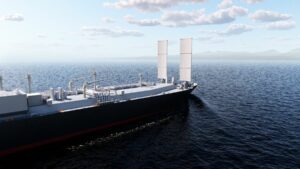02 August 2024 – ClassNK has issued an Approval in Principle (AiP) for the membrane-type LNG carrier installed with the ‘Wind Challenger’, a hard sail wind propulsion system. The ship is jointly developed by Mitsui O.S.K. Lines, Ltd. and Hanwha Ocean Co., Ltd. This marks the world’s first AiP for an LNG carrier equipped with a Wind-Assisted Propulsion System (WAPS).

As a solution for responding to the environmental regulations and fuel cost reduction, the implementation of wind-assisted propulsion systems is in progress. When such systems are installed on board ships, it is expected to be effective in reducing CO2 emissions, etc., by taking advantage of wind power. However, depending on the scale and specifications, they also pose risks to ship’s structure, crew on board, and the surrounding environment.
To provide safety guidance for addressing these risks appropriately, ClassNK published the ‘Guidelines for Wind-Assisted Propulsion Systems for Ships’ as a standard for wind-assisted propulsion systems and ships equipped with these systems.
ClassNK carried out a review of the conceptual design of the ship based on its ‘Rules and Guidance for the Survey and Construction of Steel Ships’, ‘Guidelines for Wind-Assisted Propulsion Systems for Ships (Edition 2.0)’, and examined the result of required risk assessment. Upon confirming they comply with the prescribed requirements, ClassNK issued the AiP.
Approval in Principle (AiP):
At the initial stage of designing or before the specific target ship to be implemented is decided, the design is examined based on the existing regulations such as international conventions and ship classification rules, and an Approval in Principle (AiP) is issued as proof of conformity with requirements. It also prevents rework of regulatory aspects in the post-process, shortens the examination time at the time of class registration, and can be used as a technical basis for external appeal of the design status. For more information, visit our website.
